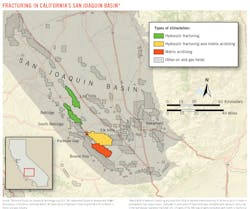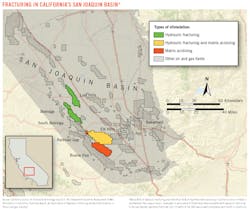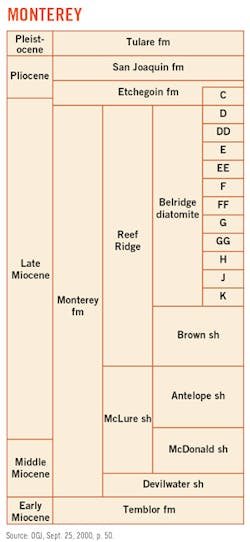Scientists call for assessment of shales resources in California
No reliable estimates exist of potential oil production using hydraulic fracturing in California's Monterey formation, and the state should request a credible scientific assessment, said an independent scientific assessment of well stimulation in California.
The California Council on Science & Technology (CCST) and Lawrence Berkeley National Laboratory (LBL) noted California's experience with fracturing differs from common practices in other states because California wells tend to be less than 2,000 ft. In addition, California's reservoirs are more permeable than plays elsewhere.
The CCST-LBL assessment suggested the state of California should request a peer-reviewed assessment of shale resources and that the state should track well permits for future drilling in the oil window of the Monterey and Kreyenhagen.
"Expansive production in the Monterey formation remains possible," the report said.
Researchers said many questions remain for state officials following a scientific perspective that included no economic analysis.
In 2013, the California Legislature passed Senate Bill 4 (SB4), setting the framework for regulations of fracturing and acid stimulation technologies.
"California operations generally do not conduct high-volume hydraulic fracturing from long-reach wells, and for this reason use far less water," said a summary report of the CCST-LBL assessment.
A Sacramento nonprofit organization, CCST was established in 1988 upon the request of the California state government to improve science and technology policy and application in California.
CCST-LBL researchers forecast that fracturing in California during the next few years is expected to look much like it already looks today.
The highest potential for future fracturing is in areas where oil and natural gas activities already exist. Currently, fracturing enables 20-25% of California's production, the report said.
Oil resource assessment and future use of fracturing in the Monterey formation of California remains uncertain, the report said, noting the Energy Information Administration's resource estimates from 2011 and 2014 provided little documentation.
"The geological conditions in California do not likely include basin-wide gas accumulations," the report said, noting the Sacramento basin does not exhibit the geology of the Marcellus or Barnett plays.
Water use low
Researchers noted fracturing in California consumes on average 140,000 gal of water per well compared with about 4 million gal/well in the South Texas Eagle Ford. The state of New York banned fracturing using more than 300,000 gal per well.
"More than 90% of California operations use less than 300,000 gal of water per well," the report said. "Consequently, if California were to enact the same ban on hydraulic fracturing as enacted in New York, the ban would make little difference to current hydraulic fracturing practice[s]."
Operators in California use about 800 acre-ft/year of water for fracturing, and researchers said that does not represent a large amount of freshwater compared with other water uses.
Fracturing tends to be concentrated in relatively water-scarce regions, the report said. The state has begun requiring detailed reporting of water use and produced water disposal in California's oil and gas fields according to SB1281.
"This data will help to illuminate opportunities for water reuse and water practices that could be optimized or should be disallowed or controlled," the report said.
California operators use fracturing on a small portion of offshore wells although most offshore production takes place without fracturing.
"Most of the limited hydraulic fracturing activity is conducted on engineered islands close to the Los Angeles coastline in state waters," the report said. "According to our limited data sources, little hydraulic fracturing takes place on platforms in federal waters more than 3 nautical miles offshore."
Researchers said 90% of offshore fracturing operations occurred on dedicated islands in Wilmington field. Operators complete 4-9 wells/month, of which 1-2 wells are completed with fracturing.
"Operations on close-to-shore, dedicated islands resemble onshore oil production activities," the report said. Record-keeping requirements for fracturing and acid stimulation done in federal waters does not meet state standards, researchers added.
The US government does not maintain a web site or other public portal with information about fracturing from platforms in federal waters.
The report recommended California state officials request the federal government improve data collection and record-keeping concerning well stimulation in federal waters to at least match SB4 requirements.


